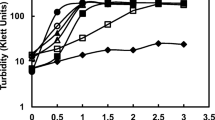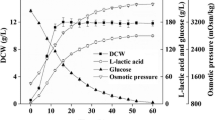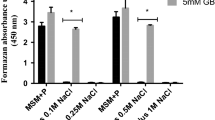Abstract
Changes in intracellular composition after hyperosmotic shock were studied in the lysine-producing mutant Brevibacterium lactofermentum NRRL B-11470 and the wild-type Corynebacterium glutamicum ATCC 13032. Both strains accumulated betaine, proline, glutamic acid, glutamine and trehalose in response to stress. The accumulated amino acids were synthesized by the cells, while betaine and trehalose were taken up from the medium. The contribution of synthesized osmoregulators was highest in C. glutamicum. In a sucrose-limited continuous culture, the increased outer osmotic pressure was balanced within 15 min for C. glutamicum and somewhat later in B. lactofermentum. The rapid regulation was due to both accumulation of osmoregulators, and shrinkage of cell and cytoplasmic volume. Immediately after shock, glutamine and glutamic acid were the dominating osmolytes. During the adaptation process, glutamine was replaced by the better osmoprotectant proline. In betaine-enriched cultures, betaine accumulation increased at the expense of glutamic acid, glutamine and trehalose. The total intracellular concentration of osmolytes increased linearly with increasing stress for all stress factors.
Similar content being viewed by others

References
Cairney J, Booth IR, Higgins CF (1985) Salmonella typhimurium proP gene encodes a transport system for the osmoprotectant betaine. J Bacteriol 164:218–1223
Czonka LN (1989) Physiological and genetic responses of bacteria to osmotic stress. Microbiol Rev 53:121–147
Dinnbier U, Limpinsel E, Schmid R, Bakker EP (1988) Transient accumulation of potassium glutamate and its replacement by trehalose during adaption of growing cells of Escherichia coli K-12 to elevated sodium chloride concentration. Arch Microbiol 150:348–357
Dreywood R (1946) Qualitative test for carbohydrate material. Ind Eng Chem Anal Ed 18:499
Frings E, Kunte HJ, Galinski EA (1993) Compatible solutes in representatives of the genera Brevibacterium and Corynebacterium: occurrence of tetrahydropyrimidines and glutamine. FEMS Microbiol Lett 109:25–32
Gervais P, Marechal PA, Molin P (1992) Effects of the kinetics of osmotic pressure variation on yeast viability. Biotechnol Bioeng 40:1435–1439
Hansen HA, Emborg C (1992) Experimental design in the development and characterization of a high performance liquid chromatographic method for amino acids. J Chromatogr 626:171–180
Kawahara Y, Ohsumi T, Yoshihara Y, Ikeda S (1989) Proline in the osmoregulation of Brevibacterium lactofermentum. Agric Biol Chem 53:2475–2479
Kawahara Y, Yosihara Y, Ikeda S, Hirose Y (1990) Effect of glycine betaine, an osmoprotective compound on the growth of Brevibacterium lactofermentum. Appl Microbiol Biotechnol 33:574–577
Knowles JC, Smith L (1971) Effect of osmotic pressure of the medium on the volume of intact cells of Azotobacter vinelandii and the rate of respiration. Biochim Biophys Acta 234:144–152
Larsen PI, Sydnes LK, Landfald B, Strøm AR (1987) Osmoregulation in Escherichia coli by accumulation of organic osmolytes: betaines, glutamic acid, and trehalose. Arch Microbiol 147:1–7
Le Rudulier D, Strøm AR, Dandekar AM, Smith LT, Valentine RC (1984) Molecular biology of Osmoregulation. Science 244:1064–1068
Liebl W, Ehrmann M, Ludwig W, Schleifer KH (1991) Transfer of Brevibacterium divaricatum DSM 20297T, “Brevibacterium flavum” DSM 20411, “Brevibacterium lactofermentum” DSM 20412 and DSM 1412, and Corynebacterium lilium DSM 20137T to Corynebacterium glutamicum and their distinction by rRNA gene restriction patterns. Int J Syst Bacteriol 41:255–260
Loewus FA (1952) Improvement in anthrone method for determination of carbohydrates. Anal Chem 24:219
Measures JC (1975) Role of amino acids in osmoregulation of nonhalophilic bacteria. Nature 257:398–400
Mitchell P, Moyle J (1956) Osmotic function and structure in bacteria. Symp Soc Gen Microbiol 6:150–180
Shiio I, Narui K, Yahaba N, Takahashi M (1962) Free intracellular amino acid of a glutamate-forming bacterium, Brevibacterium flavum no 2247. J Biochem (Tokyo) 51:109–111
Skjerdal OT, Sletta H, Flenstad SG, Josefsen KD, Levine DW, Ellingsen TE (1995) Changes in cell volumes, growth and respiration rate in response to hyperosmotic stress of NaCl, sucrose and glutamic acid in Brevibacterium lactofermentum and Corynebacterium glutamicum. Appl Microbiol Biotechnol 43:1099–1106
Stock BJ, Rauch B, Roseman S (1977) Periplasmic space in Salmonella typhimurium and Escherichia coli. Biol Chem 252:7850–7861
Strøm AR, Falkenberg P, Landfald B (1986) Genetics of osmoregulation on Escherichia coli: uptake and biosynthesis of organic osmolytes. FEMS Microbiol Rev 39:79–86
Tsuchida T, Murakami Y, Nishimoto Y, Kotani T (1992) Method of producing trehalose. European patent application, 0 555 540 A1
Tosaka O, Ishihara M, Morioko H, Takinami K (1981) Method for the production of l-lysine, United States patent 4 275 157
Yancey PH, Clark ME, Hand SC, Bowlus RD, Somero GN (1982) Living with water stress: evolution of osmolyte systems. Science 217:1214–1222
Author information
Authors and Affiliations
Rights and permissions
About this article
Cite this article
Skjerdal, O.T., Sletta, H., Flenstad, S.G. et al. Changes in intracellular composition in response to hyperosmotic stress of NaCl, sucrose or glutamic acid in Brevibacterium lactofermentum and Corynebacterium glutamicum . Appl Microbiol Biotechnol 44, 635–642 (1996). https://doi.org/10.1007/BF00172497
Received:
Revised:
Accepted:
Issue Date:
DOI: https://doi.org/10.1007/BF00172497



